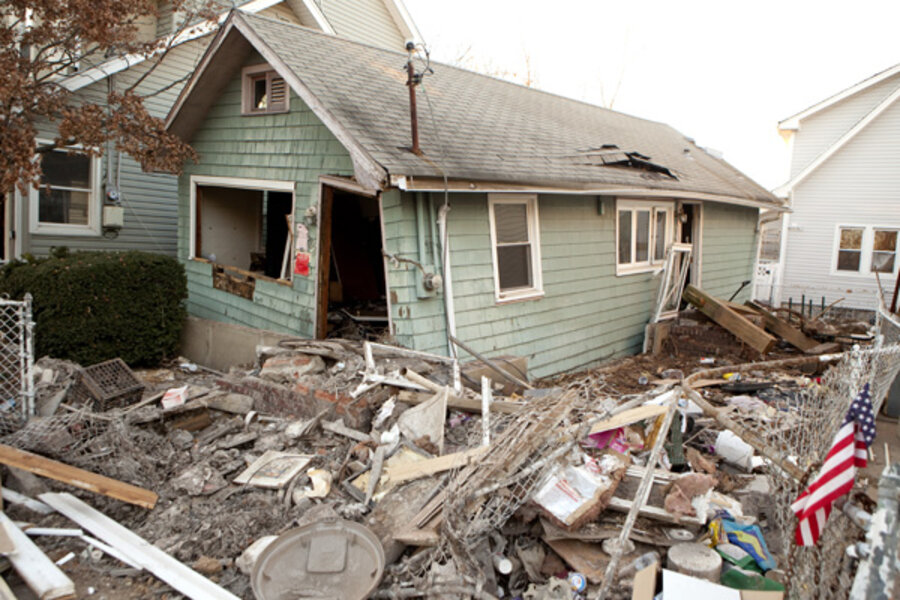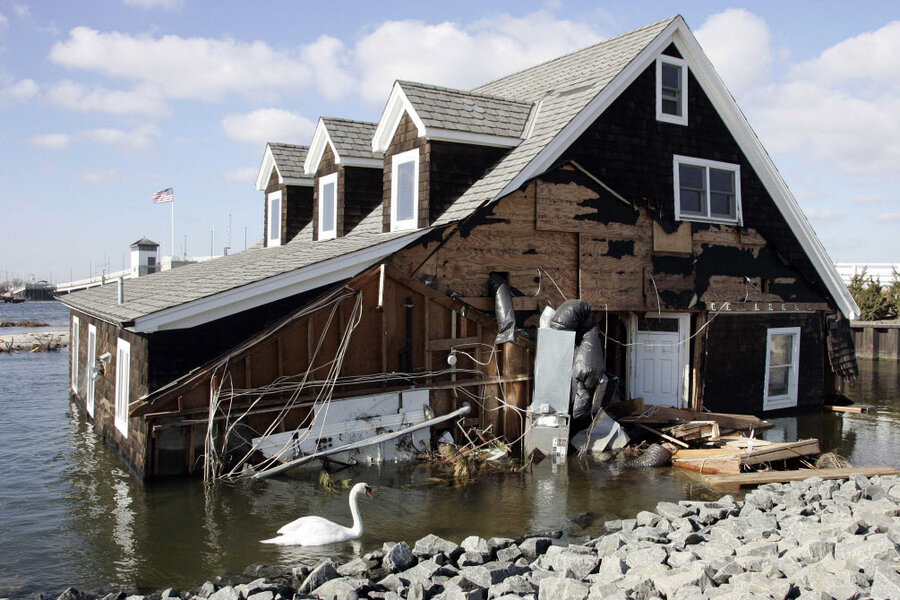Sandy recovery claims mount. How much will a divided Congress pay?
Loading...
| New York
The US may be perched on the edge of the “fiscal cliff,” with Republicans demanding spending cuts and Democrats clamoring for tax hikes to reduce the budget deficit.
But, one thing both parties are likely to agree on: spending billions and billions of dollars to help New Jersey, New York, Connecticut, and other states recover from superstorm Sandy.
Within the last two days, the governors of New York and New Jersey have released estimates that they will need a combined $79 billion ($42 billion for New York and $37 billion for New Jersey) to pay for repairs, restoration, and mitigation against future storms. Connecticut expects to send its request in shortly.
On Wednesday, New York Mayor Michael Bloomberg flew to Washington for meetings just about every thirty minutes with congressional leaders. On Monday, he said the city would like an additional $9.8 billion for storm damage on top of $5.4 billion that they have already submitted to FEMA.
He probably could have saved the airfare because budget experts think Congress is likely to open up the checkbook for this disaster.
“They will pretty much get what they ask for,” says Stan Collender, a budget authority and a partner at Qorvis Communications in Washington.
“Historically, Congress has been quite generous when there are disasters,” says Pete Davis of Davis Capital Investment Ideas in Washington, which advises Wall Street clients. “It won’t be in the lame duck session, it will be next year.”
The money will likely come in the form of an emergency supplemental spending bill that will go through Congress once it resolves its current differences over spending and taxes. “If it weren’t for the fiscal cliff this would get done really quickly,” says Mr. Davis.
But, won’t spending another $80 billion to $100 billion throw those calculations out of line?
“It will expand the deficit,” agrees Mr. Collender. But, that is not likely to matter, he and others say.
“Traditionally, supplemental spending bills are not paid for,” explains Davis. For example, the US wars in Afghanistan and Iraq have been funded by supplemental spending bills.
One of the reasons Congress is so generous is that every senator and representative is keenly aware that a disaster can take place in their district at any time. In the West, wildfires can destroy communities. In the Midwest a drought can hurt farmers. Along the Gulf Coast, there could be another big oil spill.
The governors seeking federal money can also point to how generous Congress was after Hurricane Katrina ripped through Louisiana, Mississippi, and Alabama in 2005.
“In the past decade Congress has authorized supplemental appropriations after hurricanes, floods, and tornadoes, including $120 billion worth of aid in several bills passed in the aftermath of Hurricane Katrina,” wrote Bloomberg in his letter requesting Federal aid on Monday.
In fact, the Gulf Coast delegation and the Army Corps of Engineers kept coming back to Congress for more and more money, recalls D.J. Nordquist, who was working at the office of the federal coordinator for Gulf Coast rebuilding at the time.
The comparison is not lost on the Northeast governors. In his request for funding, New York Gov. Andrew Cuomo compared the damage done by Sandy and Katrina. In the three categories he picked, housing, power outages, and businesses impacted, Sandy was more significant.
As Ms. Nordquist notes, politicians have been known to exaggerate before. She recalls that Louisiana Sen. Mary Landrieu asked for $250 billion to start with. “Her strategy was to ask for something astronomical,” she recalls.
In the case of Sandy, the numbers are also ticking upward very quickly. On Friday, Nov. 23, Gov. Chris Christie of New Jersey asked for $29 billion. On Wednesday he revised the number to $37 billion to cover measures to protect the state from future disasters.
In Christie’s request for aid, he added that he might still need more money. “The estimate will likely be refined further to consider and include the long-term impact on the next tourism season, shifts in population, impact on real estate values, and other factors,” he said in a letter to Congress.
Governor Cuomo also wants a large amount of money to prevent future damage. He’s asked for $9.1 billion for what he termed “common sense” mitigation and prevention costs such as flood protection for the World Trade center site and the subway system.
Bloomberg’s strategy on Wednesday was to try to make support for shelling out the money a nonpartisan issue. He met with deficit hawks such as Rep. Eric Cantor (R) of Virginia and Sen. Mitch McConnell (R) of Kentucky and with Democratic leaders including Rep. Nancy Pelosi of California and Senate majority leader Harry Reid of Nevada.
“Now, we have to bring together both sides in Washington – and both ends of Pennsylvania Avenue,” he said at a press conference late in the day Wednesday. “Hurricane recovery is not a partisan issue.”








